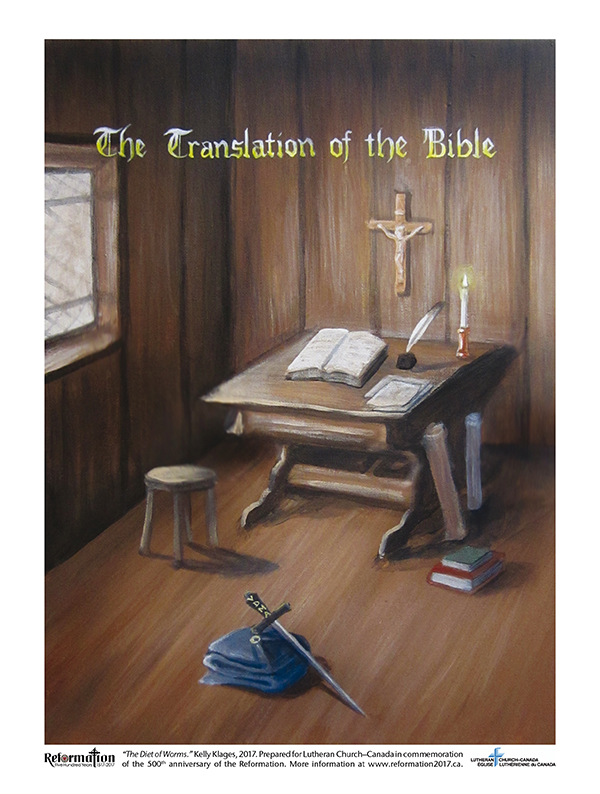Reformation 2017 Artwork: The Translation of the Bible
Editor’s Note: Kelly Klages has agreed to prepare six pieces of original art for Lutheran Church–Canada (LCC) commemorating the 500th anniversary of the Reformation in 2017. Each piece of art will be featured on the covers of this year’s issues of The Canadian Lutheran magazine.
In addition, each piece of art is being made available to LCC congregations as a free, downloadable poster. You can print out the posters, along with accompanying artist’s statement, as they become available at www.reformation2017.ca/resources/posters/.
by Kelly Klages
 A couple of weeks ago, my husband received a book order in the mail. It was a beautiful facsimile of an original Luther Bible (published by Taschen). Luther’s translation of the Bible from Greek and Hebrew—the task with which he laboured during his secret stay in Wartburg Castle in the early 1520s—is often considered the single most significant and valuable accomplishment of his entire life. Historically, its importance is undisputed. Having the Scriptures in the vernacular changed the place of the Bible in the lives of the German people forever. The new German Bible influenced subsequent English translations, including the King James Bible. It is comparable to the King James for its role in standardizing the language itself. The prevalence of print copies had a lasting impact on issues like literacy and education. Even Luther’s critics praised his masterful skill and vibrant use of language. If Luther had accomplished nothing else in his entire career, his translation of the Bible would be enough to secure his place in history.
A couple of weeks ago, my husband received a book order in the mail. It was a beautiful facsimile of an original Luther Bible (published by Taschen). Luther’s translation of the Bible from Greek and Hebrew—the task with which he laboured during his secret stay in Wartburg Castle in the early 1520s—is often considered the single most significant and valuable accomplishment of his entire life. Historically, its importance is undisputed. Having the Scriptures in the vernacular changed the place of the Bible in the lives of the German people forever. The new German Bible influenced subsequent English translations, including the King James Bible. It is comparable to the King James for its role in standardizing the language itself. The prevalence of print copies had a lasting impact on issues like literacy and education. Even Luther’s critics praised his masterful skill and vibrant use of language. If Luther had accomplished nothing else in his entire career, his translation of the Bible would be enough to secure his place in history.
If Luther had accomplished nothing else in his entire career, his translation of the Bible would be enough to secure his place in history.
The reformers saw the tidal wave of reformation as a demonstration of the power of the Word of God. Luther himself did not claim credit. “I simply taught, preached, and wrote God’s Word; otherwise I did nothing. And then, while I slept, or drank Wittenberg beer with my Philip and my Amsdorf, the Word so greatly weakened the papacy that never a prince or emperor did such damage to it.” The Bible’s availability to pastor, prince, and pauper was a great equalizer. To hear, read, and learn God’s will, and His gracious Gospel promises, was a new gift to a great many people. The translation of the Bible into various languages for the edification of God’s people still continues today. Our own abundant resources for accessing the Scriptures should humble us—let us never take for granted all we have been given!
For my painting, I consulted images of the room in the Wartburg where Luther lived as he worked on translation, incorporating some new symbolic touches. The open book on the desk, equipped with quill, faces a wall crucifix—an ongoing remembrance that at the heart of all Scripture is Christ’s love for sinners in His death and resurrection. The lit candle represents faith, which has God’s Word as its object. On the floor in the foreground is a folded garment and sword, representing Luther’s temporary alter-ego as “Knight George” at the Wartburg. The sword hilt bears the letters “VDMA.” This stands for Verbum Domini Manet in Aeternum (“The Word of the Lord Endures Forever”), the motto of the Lutheran Reformation.
———————
Kelly Klages is an artist and member of Lutheran Church–Canada living in Morden, Manitoba.





